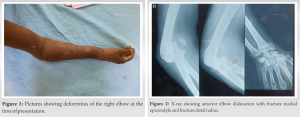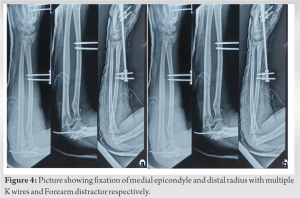Anterior elbow dislocation is one of the rare elbow injury, as discussed in the literature and it is usually associated with periarticular fractures. It needs prompt intervention and fracture fixation for early recovery and better functional outcome. The mechanism of injury and method of reduction are learning points in this rare case report.
Dr. Subhamya Chinmaya Swain, Department of Orthopaedics, VIMSAR Burla, Sambalpur - 768 017, Odisha, India. E-mail: subhacs61@gmail.com
Introduction: Anterior elbow dislocation is a rare occurrence, mostly produced by direct trauma to elbow in flexion attitude following fall from height. Posterior dislocation is the commoner entity at the elbow joint, thus rarity of this case incites reporting.
Case Report: A 53-year-old male presented to our outpatient department with complaints of pain, swelling, and inability to move his right upper limb, following fall from height. On examination, no associated neurovascular deficit was found. Radiological investigations confirmed anterior dislocation of elbow joint with medial epicondyle fracture of the right humerus. Dislocation was reduced under general anesthesia with ulnohumeral K-wire and fracture of the medial epicondyle was stabilized by open reduction and internal fixation with K-wire.
Conclusion: Anterior dislocation is a rare occurrence with frequent association of neurovascular injury. Therefore, a careful assessment followed by the early proper reduction and management of neurovascular injury if any would lead to better functional outcome.
Keywords: Elbow joint, anterior dislocation, medial epicondyle.
Traumatic anterior elbow dislocation is an uncommon rare injury [1, 2]. It is usually associated with periarticular fractures [3, 4] or neurovascular deficit [5]. The aim of the treatment is to provide a good clinical and functional outcome with concentric reduction, good fixation of periarticular fractures with adequate soft-tissue handling with best available methods [6, 7]. Till now, very few cases of anterior elbow dislocation are reported in the literatures and are usually associated with neurovascular or ligamentous injury.
A 53-year-old male presented to emergency department with complaints of pain, swelling, and deformity around the right elbow joint with inability to move his right elbow (Fig. 1). He had a history of fall on palm with hyperflexed elbow while performing his household chores in the same morning. On presentation, he was holding his left elbow semiflexed and supported by opposite hand. On examination, his elbow was at 30° flexed attitude, forearm in mid-prone position swelling and tenderness was observed around the right elbow and wrist region. The three point relationship of the right elbow was lost. Olecranon was not palpable posteriorly; there was increased tenderness on palpation over medial condylar region. There was also tenderness over the right wrist and restriction of movement around the wrist joint. The range of motion around the right elbow was painful and restricted without any distal neurovascular deficit.

Anterior elbow dislocation is among the rarest of the injuries in contrast to posterolateral elbow dislocation, which is a common occurrence and is usually associated with periarticular fractures [1]. Majority of the reported cases had associated fractures of olecranon, medial and lateral epicondyle, and radial head [2, 5]. The mechanism of injury described in various literatures are that, it may occur due to a direct trauma to posterior aspect of ulna with elbow in mid flexed position [3, 10] or may be due to sudden pull on forearm in an attempt to prevent a fall [1]. We believe that the mechanism may be due to fall on palm with hyperflexed elbow that results in axial loading of forearm and wrist, explaining anterior dislocation and distal radius fracture at the same time torsional forces result in medial epicondylar fracture [4, 8, 11]. The elbow joint owes its stability to the ulnotrochlear articulation and collateral ligament complexes which are its primary static stabilizers. The radial head, joint capsule, common flexor, and extensor origin which are the secondary static stabilizers and anconeus, triceps, brachialis muscles act as the dynamic stabilizers [4, 12]. The posterior column is formed by the olecranon, the triceps, and the posterior aspect of capsule. This explains the rare occurrence of anterior elbow dislocation. To have anterior dislocation, the disruption of the posterior column is necessary [8, 13]. The clinical picture in acute anterior elbow dislocation found to be, elbow in a flexed attitude, pain, swelling, deformity, range of motion restricted by pain, and usually associated with soft-tissue injuries [7]. This case report is that of closed anterior dislocation with medial epicondyle fracture humerus and distal radius fracture, without any neurovascular deficit. Anterior dislocation mostly occurs with fracture olecranon dislocation with medial epicondyle that is also a known entity, which is more common than lateral epicondyle [8, 14]. Mostly, the underlying mechanism is direct trauma to posterior aspect of elbow and to wrist. After initial evaluation, the patient was treated by closed reduction of elbow joint with medial epicondyle fracture fixation with the help of K-wire due to small subarticular fragment [5, 8]. Medial epicondylar fractures are traditionally treated conservatively which leads to fibrous union rather than bony union [15]. Here, we have fixed the fragment to prevent severe chronic medial instability although it rarely occurs with fibrous union [8]. We followed the reduction maneuver of gentle traction to the forearm, the posterior and downward pressure is applied to the forearm with gentle anterior pressure on the distal humerus, and the method opposite to the reduction maneuver for posterior elbow dislocation [2].
Anterior dislocation of elbow although very rare may be associated with periarticular fractures, which results in compromised stability. Accurate diagnosis. Concentric reduction and periarticular fracture fixation around the joint is the key for normal functional outcome of the elbow.
Although anterior elbow dislocation is rare in occurrence, high index of suspicion has to be there in mind to rule out anterior elbow dislocation patients presenting with mid flexed elbow and history of direct injury to the elbow. Even though the injury is predominantly closed, there is a high incidence of associated soft-tissue injury, periarticular fractures, and neurovascular injury. Early detailed evaluation and management are essential for an optimal functional outcome.
References
- 1.Nema SK, Behera G, Poduval M. Neglected anterior dislocation of the elbow joint: Case report of a rare injury. Malays Orthop J 2018;12. [Google Scholar]
- 2.Kailash S, Shanmuganthan S, Anterior dislocation of elbow with neurovascular injury: A rare case report. J Orthop Case Rep 2017;7:91-4. [Google Scholar]
- 3.Wu Y, Jiang H, Miao W. A case report of children’s divergent dislocation of the elbow and review of literature. Medicine (Baltimore) 2016;95:e4772. [Google Scholar]
- 4.Vijayan S, Chalappurath V, Jose S, Rao SK. Anterior elbow dislocation without fracture in an adult: A rare injury pattern. BMJ Case Rep 2019;12:e230115. [Google Scholar]
- 5.Dhar S, Kale SY, Singh S, Gunjotikar AR, Koli V, Sharma S. Multiple Cantilever K-wiring technique for severely comminuted articular fragments in neglected distal humerus fracture with anterior elbow dislocation: A case report. J Orthop Case Rep 2022;12:22-5. [Google Scholar]
- 6.Dimantha WH, Pathinathan K, Shivakumaran D, Gunawardena PM, Madushanger SR, Wijesinghe S. Pediatric anterior elbow dislocation due to a rare mechanism of injury: A case report. Int J Surg Case Rep 2021;85:106210. [Google Scholar]
- 7.Bouaziz W, Guidara AR, Trabelsi A, Bardaa T, Hammami M, Ellouz Z, et al. Anterior transolecranon dislocation of the elbow in a child: A case report and review of literature. World J Orthop 2018;9:100-4. [Google Scholar]
- 8.Kumar R, Sekhawat V, Sankhala SS, Bijarnia I. Anterior dislocation of elbow joint-case report of a rare injury. J Orthop Case Rep 2014;4:16-8. [Google Scholar]
- 9.Leung KS, Shen WY, Leung PC, Kinninmonth AW, Chang JC, Chan GP. Ligamentotaxis and bone grafting for comminuted fractures of the distal radius. J Bone Joint Surg Br 1989;71:838-42. [Google Scholar]
- 10.Søjbjerg JO, Helmig P, Kjaersgaard-Andersen P. Dislocation of the elbow: An experimental study of the ligamentous injuries. Orthopedics 1989;12:461-3. [Google Scholar]
- 11.Robinson PM, Griffiths E, Watts AC. Simple elbow dislocation. Shoulder Elbow 2017;9:195-204. [Google Scholar]
- 12.Biga N, Thomine JM. Trans-olecranal dislocations of the elbow. Rev Chir Orthop Reparatrice Appar Mot 1974;60:557-67. [Google Scholar]
- 13.Badelon O, Bensahel H, Mazda K, Vie P. Lateral humeral condylar fractures in children: A report of 47 cases. J Pediatr Orthop 1988;8:31-4. [Google Scholar]
- 14.Woods GW. American orthopaedic society for sports medicine. Am J Sports Med 1977;5. [Google Scholar]









